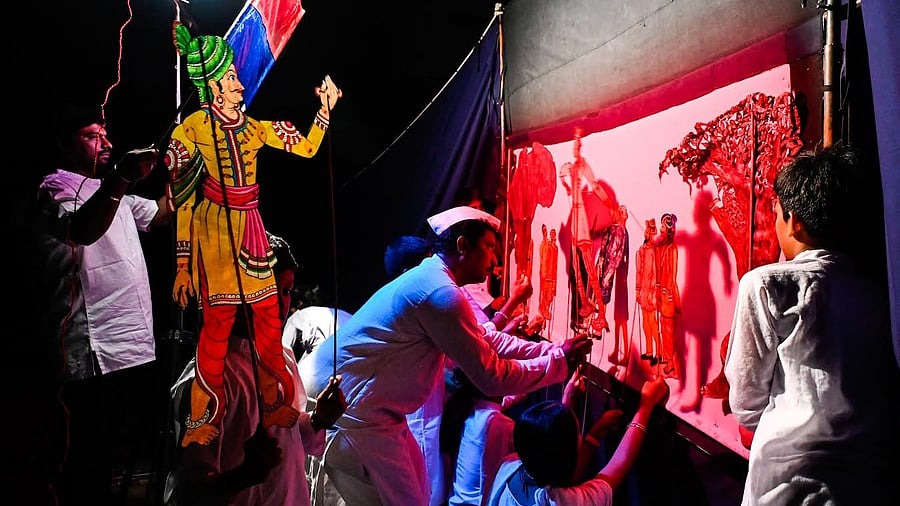
Giving a contemporary touch to the traditional Togalu Gombeyaata, some puppeteers across the state are now presenting shows on patriotic and social themes. In pic, Bapuji Togalu Gombeyaata performance at Kalaburagi.
Photo by Tazuddin Azad
In the heartlands of Karnataka, as dusk falls and the world quiets, a flicker of light behind a white screen brings centuries-old stories to life. This is Togalu Gombeyaata, Karnataka’s traditional form of shadow puppetry. A performance art rooted in epic tales, folk wisdom, coarse humour, and profound drama, it unfolds not in grand theatres but in makeshift bamboo stages under the open sky or on modest platforms, often stretching from night till dawn.
Literally meaning ‘a play with leather dolls’, Togalu Gombeyaata blends song and prose, and community storytelling.
Historically, Togalu Gombeyaata flourished under the patronage of powerful South Indian dynasties, the Rashtrakutas, Pallavas, Chalukyas, Kadambas and Hoysalas. Later, the Vijayanagara and the Mysore kingdoms supported this performing art, offering land grants and patronage to puppeteer communities.
One such community is the Killekyatha (or Shillekyatha). Originally believed to have migrated from the present-day southern Maharashtra, the Killekyathas spread across Karnataka, Andhra Pradesh and Tamil Nadu, carrying their art from village to village.
Of puppets and performance
The puppets used in Togalu Gombeyaata were traditionally crafted from goat or deer hide because of its translucency and ability to absorb colour. Painted in vivid hues, they were not made from animals killed specifically for the purpose; rather, hides were obtained from animals that had died naturally or been slaughtered for meat.
A Togalu Gombeyaata performance typically begins with invocations to deities Ganesha and Saraswati, followed by a humorous exchange between Killekyata and his wife Bangarakka. Then, the central narrative unfolds, often drawn from the Ramayana, Mahabharata, Puranas, or folk tales.
Photo by M S Manjunath
But in recent years, there is a conscious shift. “Now, we either use the dolls made years ago or make dolls with plant-based and synthetic materials, aiming to reduce animal harm while preserving the craft,” said Narayanappa Shillekyatha of Ballari.
He added that there are primarily two types of Togalu Gombeyaata in Karnataka, the Chikka Theatre where smaller puppets (20–30 cm) are used, and the Dodda Theatre where larger ones (up to 120 cm) are used.
Within these, regional variations exist based on the manipulation techniques, music, folk-theatre and morphology of figures, inspired by the sculpted and painted elements found in local temples.
“In Uttara Kannada and Dakshina Kannada, Gombeyaata’s close relationship with Yakshagana is a defining characteristic. The elaborate costumes, headgear, and makeup of the puppets are directly inspired by the Yakshagana Bayalata characters, making the puppet shows a miniature, mobile version of the larger traditional theatre form,” explains Bhaskar Kogga Kamath, president of Uppinakundru Gombemane, Kundapur.
In Vijayapura and Kalaburagi, the form is known as Katabarata, featuring puppets between one and four feet tall. In Ballari and Dharwad, the Killekyatha style uses puppets as tall as five feet. In the districts of Bengaluru and Kolar and those closer to Andhra Pradesh, the form is practised with large puppets. A Togalu Gombeyaata performance typically begins with invocations to deities Ganesha and Saraswati, followed by a humorous exchange between Killekyatha and his wife Bangarakka. Then, the central narrative unfolds, often drawn from the Ramayana, Mahabharata, Puranas, or folk tales.
Accompanied by a vibrant musical ensemble — flute, dhol, cymbals, mukhavina, pungi, and ektari — puppeteers manipulate the leather figures behind a lit screen. Modern performances now use electric lights instead of oil lamps.
“A single night’s play may use over 50 puppets, including elaborate figures of animals, birds, gods, and demons,” says puppeteer Arvind Shenoy.
Even the stories depend on the season. For instance, certain stories are told during harvest seasons, pre-monsoon rituals, or wedding festivities, deeply embedding the form in fertility traditions.
Survival in the age of screens
Despite its rich legacy, Togalu Gombeyaata is fading.
Earlier, family troupes, each assigned a specific set of villages, would travel with a collapsible stage — roughly 3x3 metres wide and 2.5 metres tall — made from bamboo sticks, cloth, and blankets. They would also perform all night. However now, most puppeteers perform on invitation-basis and restrict the shows to a couple of hours.
“In the early 1970s, Karnataka had over 50 regional leather puppet troupes. Today, only a handful survive,” said Kamath.
“The main reason is the rise of modern digital entertainment. Audiences have dwindled, and sponsors are scarce. Without adequate government support, many artists have had to take up other professions to survive,” he adds.
Yet, the art form still thrives in some pockets. In the coastal towns of Kundapura, Udupi and Mangaluru, puppet shows are staged during festivals, says Divakar Shenai, a long-time organiser. Summer workshops for children on Togalu Gombeyaata help spark interest in the younger generation.
Efforts are also being made to adapt traditional formats to contemporary themes.
Recently, a special puppet show was held at the horticulture fair in Bengaluru to educate farmers on modern agriculture practices and technology.
“The story written by Ramya H R, an agriculture scientist, was woven around farmers as it could convey our message effectively,” said K V Ramesh, a puppeteer.
He added that they also perform plays on various subjects such as female foeticide and population control, but mythological narratives still draw the most interest.
Some teachers have also adopted puppetry in pedagogy. “I have taught making puppets to students as well. It not only develops their creativity but makes lessons more interesting for students,” said Mallikarjun Koralli from Kalaburagi.
Togalu Gombeyaata, once a vibrant, all-night community affair, now teeters on the edge of obscurity. But behind the flickering shadows on a white cloth screen lies a vast, living archive of Karnataka’s history, culture, and imagination, one worth preserving for generations to come.